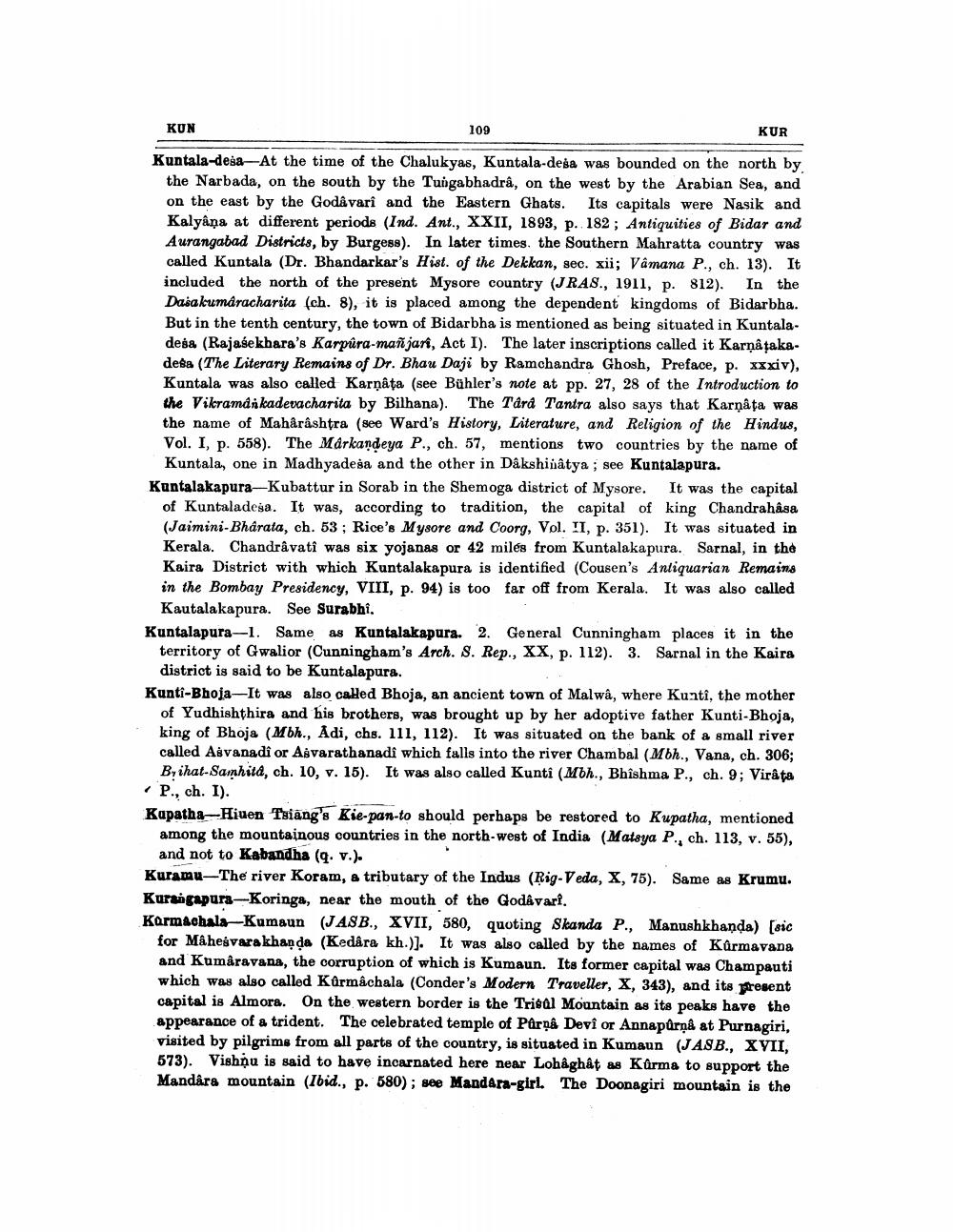________________
KUN
109
KUR
Kuntala-des-At the time of the Chalukyas, Kuntala-desa was bounded on the north by,
the Narbada, on the south by the Tungabhadrâ, on the west by the Arabian Sea, and on the east by the Godavari and the Eastern Ghats. Its capitals were Nasik and Kalyana at different periods (Ind. Ant., XXII, 1893, p. 182; Antiquities of Bidar and Aurangabad Districts, by Burgess). In later times, the Southern Mahratta country was called Kuntala (Dr. Bhandarkar's Hist. of the Dekkan, sec. xii; Vâmana P., ch. 13). It included the north of the present Mysore country (JRAS., 1911, p. 812). In the Dasakumdracharita (ch. 8), it is placed among the dependent kingdoms of Bidarbha. But in the tenth century, the town of Bidarbha is mentioned as being situated in Kuntaladesa (Rajasekhara's Karpûra-mañ jari, Act I). The later inscriptions called it Karnâțakadesa (The Literary Remains of Dr. Bhau Daji by Ramchandra Ghosh, Preface, p. xxxiv), Kuntala was also called Karnata (see Bühler's note at pp. 27, 28 of the Introduction to the Vikramdi kadevacharita by Bilhana). The Tara Tantra also says that Karnața was the name of Maharashtra (see Ward's History, Literature, and Religion of the Hindus, Vol. I, p. 558). The Markandeya P., ch. 57, mentions two countries by the name of
Kuntala, one in Madhyadesa and the other in Dakshinâtya ; see Kuntalapura. Kuntalakapura-Kubattur in Sorab in the Shemoga district of Mysore. It was the capital
of Kuntaladesa. It was, according to tradition, the capital of king Chandrahasa (Jaimini-Bharata, ch. 53 ; Rice's Mysore and Coorg, Vol. !I, p. 351). It was situated in Kerala. Chandravati was six yojanas or 42 miles from Kuntalakapura. Sarnal, in the Kaira District with which Kuntalakapura is identified (Cousen's Antiquarian Remains in the Bombay Presidency, VIII, p. 94) is too far off from Kerala. It was also called
Kautalakapura. See Surabhi. Kuntalapura-1. Same as Kuntalakapura. 2. General Cunningham places it in the
territory of Gwalior (Cunningham's Arch. S. Rep., XX, p. 112). 3. Sarnal in the Kaira
district is said to be Kuntalapura. Kunti-Bhoja-It was also called Bhoja, an ancient town of Malwâ, where Kuntî, the mother
of Yudhishthira and his brothers, was brought up by her adoptive father Kunti-Bhoja, king of Bhoja (Mbh., Adi, chs. 111, 112). It was situated on the bank of a small river called Asvanadi or Asvarathanadi which falls into the river Chambal (Mbh., Vana, ch. 306; Bihat-Samhita, ch. 10, v. 15). It was also called Kunti (Mbh., Bhishma P., ch. 9; Viråta
P., ch. I). Kapatha---Hiuen Triang's Kie-pan-to should perhaps be restored to Kupatha, mentioned
among the mountainous countries in the north-west of India (Matsya P., ch. 113, v. 55),
and not to Kabandha (q. v.). Kuramu-The river Koram, a tributary of the Indus (Rig Veda, X, 75). Same as Krumu. Kurangapura-Koringa, near the mouth of the Godávarf. KarmachalaKumaun (JASB., XVII, 580, quoting Skanda P., Manushkhanda) [sic
for Mâhegvara khanda (Kedâra kh.)]. It was also called by the names of Kurmavana and Kumaravana, the corruption of which is Kumaun. Its former capital was Champauti which was also called Karmachala (Conder's Modern Traveller, X, 343), and its present capital is Almora. On the western border is the Tribal Mountain as its peaks have the appearance of a trident. The celebrated temple of Parņ& Devi or Annapurņa at Purnagiri, visited by pilgrims from all parts of the country, is situated in Kumaun (JASB., XVII. 573). Vishnu is said to have incarnated here near Lobâghât as Karma to support the Mandara mountain (Ibid., p. 580); see Mandara-girl. The Doonagiri mountain is the




